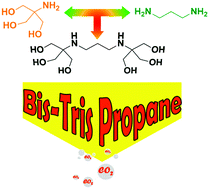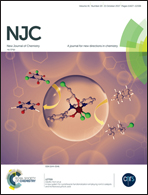Bis-tris propane in DMSO as a wet scrubbing agent: carbamic acid as a sequestered CO2 species†
Abstract
CO2 capture is a hot topic that needs to be addressed by several disciplines, to integrate the structure–activity relationships of sorbents with industrial processes and to augment individual developments into an international collaborative effort. Herein, we suggest a new model compound 1,3-bis[tris(hydroxymethyl)-methylamino]propane (BTP) dissolved in DMSO as a new wet scrubbing agent. The sequestered species was found to be a carbamic acid dimer, as verified using ex situ attenuated total reflectance-Fourier transform infrared (ATR-FTIR) spectroscopy with the emergence of a peak at 1722 cm−1, together with nuclear magnetic resonance (NMR) spectroscopy with a 13C NMR chemical shift at 157.2 ppm. The formation of carbamic acid rather than carbamate was further elucidated using 1H/13C NMR correlation spectra, with coupled cross-peaks at 3.70 ppm together with peaks at 60.3 and 157.2 ppm. Furthermore, the sorbent reusability was proven by bubbling N2 gas with a molar CO2 loading capacity of 0.91 as measured by using an in situ ATR-FTIR autoclave. 13C NMR measurements indicated that the formation of the product was kinetically, rather than thermodynamically, controlled. Tris(hydroxymethyl)aminomethane (TRIS) and 1,3-diaminopropane (DAP) were also investigated as sub-structural model units for BTP. The proposed mechanisms were studied theoretically using density functional theory (DFT).



 Please wait while we load your content...
Please wait while we load your content...